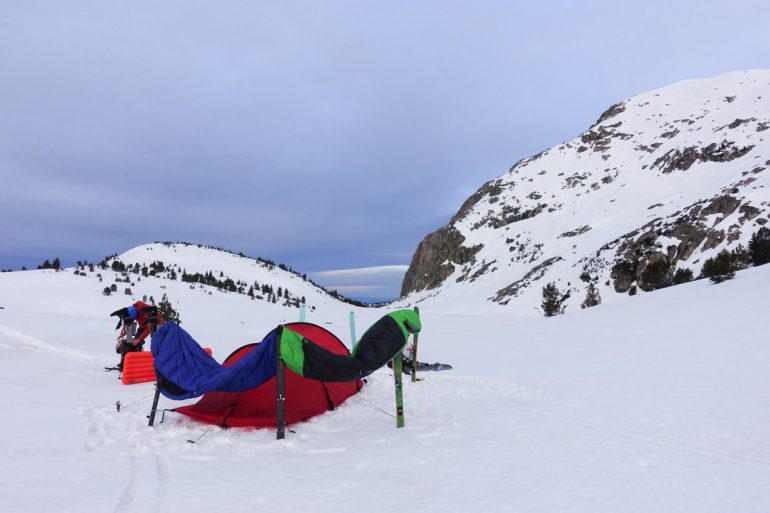
Air drying the sleep systems in the Winds. Three different sleepers rendered three distinct sleep systems.
I sleep cold. For some of you, that’s old news. On the last trip to the Winds, I slept in a mid, wearing all my warm clothes, in a 19-degree rated Patagonia down sleeping bag, and had several cold cold nights. Those clothes included Lycra tights, old down puffy pants, a R1 hoody, a midweight top, DAS Light Hoody jacket, a hat, and a buff. I learned my lesson: lighter sometimes does not mean faster if you’re not recovering with solid sleep. A few key changes this go around, we borrowed a lightweight Nallo 3 Hilleberg tent which we thought would be warmer (it was) and easier to set up (the tent required little extra shoveling to reinforce). Thanks for the tent Jed. What follows is a breakdown of the three different sleep systems used on the trip.
The Cold Sleeper Sleep System (Jason):
Sleeping bag: TNF Inferno 0F Down
I carried a heavier but warmer sleeping bag while using the same inflatable Thermarest NeoAir XTherm pad. The bag I chose was The North Face’s Inferno 0F Down bag. It’s a straight-up mummy bag, weighing 1288g/2.8lbs (compression stuff sack adds 146g), and features a half-length center zip and 800-fill water repellant Pro Down. I was sleeping to the side of a tight-fitting tent and awoke each morning to dew along the length of the bag and on the foot section. This was remedied with some brief drying time either in the AM or as we set up camp in the PM. Also, the down, which is purportedly treated to be hydrophobic, did not wet out. I was also able to stow my boot liners in the sleeping bag to dry at night. All good so far. The key here is how TNF rates this bag. They claim it is a 0F or -18C sleeping bag. This is likely accurate for warm or even warmish sleepers.
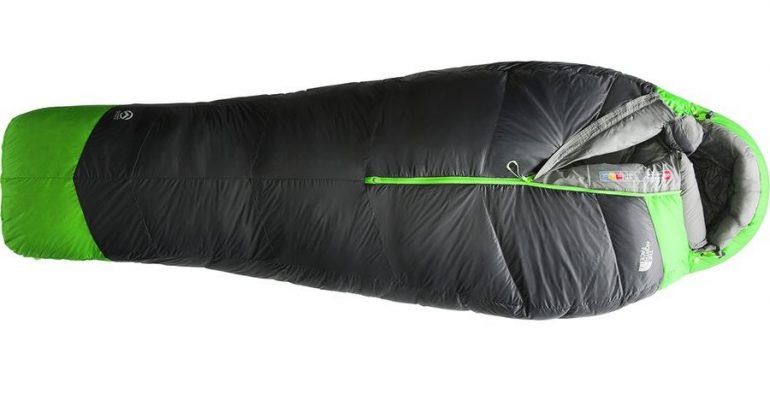
The older model of the TNF Inferno 0-degree Down sleeping bag.
For a look at sleeping bag ratings, Thermarest has a thorough breakdown of the newish EN/ISO sleeping bag rating standards. To simplify, sleeping bags have a range of temps where they are comfortable. Want more reading on the rating issue, Backpacking Light also provides insights.
One’s comfort range in a sleeping bag depends on several variables, the least of which are an individual’s “sleep temperature.” So, for example, the venerable folks at Feathered Friends (they make lovely sleeping bags) state, “Hearty climbers and thru-hikers may be willing to utilize other insulating layers to extend the comfort range of their bags (or just be a bit more uncomfortable in order to save weight), while particularly cold sleepers may want to select a bag up to 20-degrees colder than the temperatures they anticipate experiencing,” on their website.
I’m the type opting for the colder-rated bag to extend the comfort range. On this trip, I expected outside temps anywhere from the mid-20s to the mid-teens at night. I’m pretty certain that’s what we got. Inside the tent, however, with three of us sardined inside, the air temps were warmer. For me, the TNF Inferno 0F keeps me warm at 10-degrees or above temps when sleeping in an old Craft midweight top, basic tight-fit synthetic boxers, thick wool ski socks, and a hat. If I need to, I cinch down the hood, wear a buff, and seal out any potential drafts. I can zip open the half-length zip to cool off. I was comfortable in the lower teens and slept with Lycra ¾ length tights on one occasion. As a cold sleeper, the TNF Inferno 0F Down is a solid choice for me down to say 10 degrees without having to layer up with a puffy and puffy pants. Although, I did pack Patagonia’s new DAS Light Pants to be released next fall. They rule, save your pennies. More on those in a week or so.
I think on a legit 0-degree night, I’d be on the chilly side with this sleeping bag even with the extra layers. But that’s still an unknown for me. I’ve got a 25-year-old Feathered Friends bag rated to -20 with some overfill down in there if I suspect Arctic temps.

The Thermarest NeoAir XTherm sleeping pad. A R-value of 6.9 and weighing 524g with a stuff sack and patch kit. It packs down to roughly the size of a 1-liter Nalgene bottle.
Sleeping Pad: NeoAir XTherm Sleeping Pad (regular, I’m 5’10”)
As advertised, the NeoAir XTherm is relatively compact, easy to roll up and stash, and weighs 524g/1.15 lbs. (This is a mummy shape pad, not rectangular). The R-value on this pad is 6.9. Of the line of Thermarest pads, the NeoAir XTherm’s R-value is the highest-rated. Like home insulation, the R-value indicates how well the insulation, or in this case a sleeping pad, resists heat loss. The pad is also roughly $230.00, so not exactly cheap.
The bottom line is this pad works, and for the abuse I’ve given it on several ski traverses, so far, it is durable. The pad comes with a small repair kit.
Pre-sleep/during sleep routine:
I drank a cup of hot tea before bed to stoke my core. I did not, for those needing to know, bring a pee bottle. I’m good, at this point, at jumping up, donning booties, scurrying outside to pee, and hurrying back in. From my experience, holding pee is uncomfortable, and I get stressed just thinking of holding it while a quick jaunt outside solves the world’s problems or at least some of the minor ones.
Kelly Cordes
The warmer sleeper and tougher sleeper
Sleeping Bag: Patagonia Fitz Roy 850-fill-power Down with a temperature rating of 30F/-1C
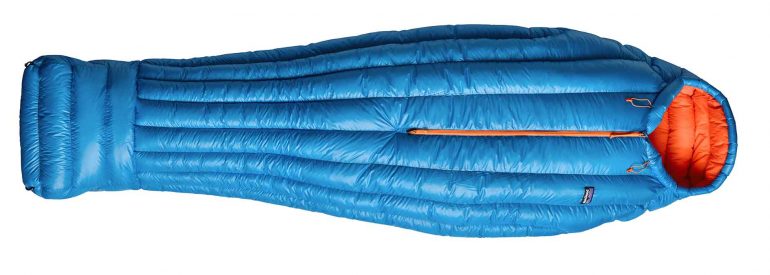
An older version of Patagonia’s Fitz Roy 850-fill-power down sleeping bag with a temperature rating of 30F/-1C. Kelly used an old version. The new version features a near full center zip. Kelly, a seasoned bivy-sufferer, was right at home with some extra clothes to offset colder temps when using this bag along with a two-piece sleeping pad system.
The bag weighs 683g/1.5lbs (without a stuff sack) and has a partial-length center zip that extends roughly 1/2 of the bag’s length. The new version’s zip is centered and runs near full length. I slept in my basic clothing system, which never left my body for six days: Merino short-sleeve T, Airshed Pro hooded pullover, buff, Cap Air bottoms, ultralight (3oz) soft shell prototype pants. I’d rotate in my dry pair of midweight wool socks (alternated two pairs, skiing and sleeping), plus a bitchin pair of synthetic booties (2.2 oz/pr). Most nights I added a light vest and a midweight shelled fleece hoody, both protos, plus a hat. On nights when the temps were expected to fall into the teens, I added my DAS Light Hoody and DAS Light Pants (both synthetic), sometimes fully worn, other times draped as partial blankets. All but the buff (Scarpa) and booties (Enlightened Equipment) are Patagonia, as I work for them in the Field Testing Department.
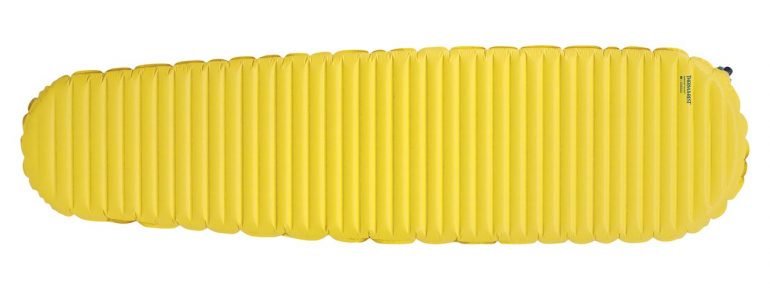
The Thermarest NeoAir XLite sleeping pad with a R-value of 5.4. Kelly used this pad in conjunction with a 1/8” Evazote foam pad from Gossamer Gear.
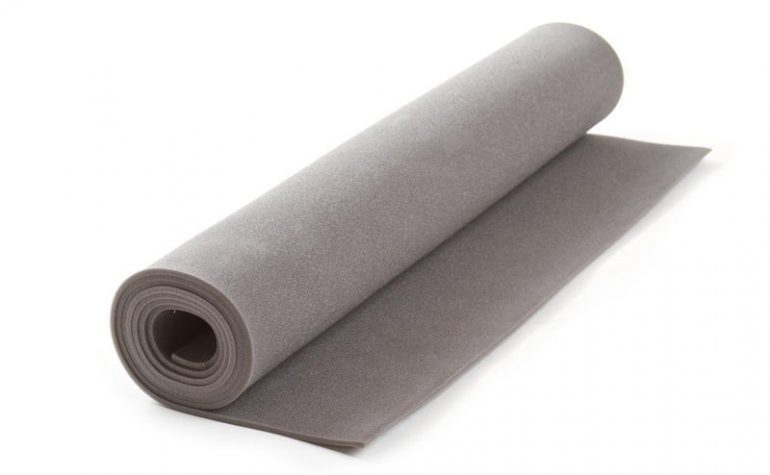
The 1/8” Evazote foam pad from Gossamer Gear.
Sleeping Pad: Thermarest NeoAir XLite (women’s; it’s my exact height at 66”), plus a 1/8″ Evazote pad.
The NeoAir XLite has a R-value of 5.4. I used the inflatable pad plus an Evazote foam pad from Gossamer Gear, cut to matching length. Adding a thin foam felt key, boosted warmth (a tip I gleaned from Backpacking Light forums), weighed only 68g, kept my Neo from sliding around, and I’d carry it on the outside of my pack to use at rest stops.
Pre-sleep/during sleep routine:
Drink hot water with a bouillon cube (yummm, salt) early, and follow with warm tea just before bed. I then tend to my horror-show toes. I do bring and use a collapsible pee bottle, which is treacherous. I’m sort of an expert. On this trip, that expertise was challenged, but not defeated.
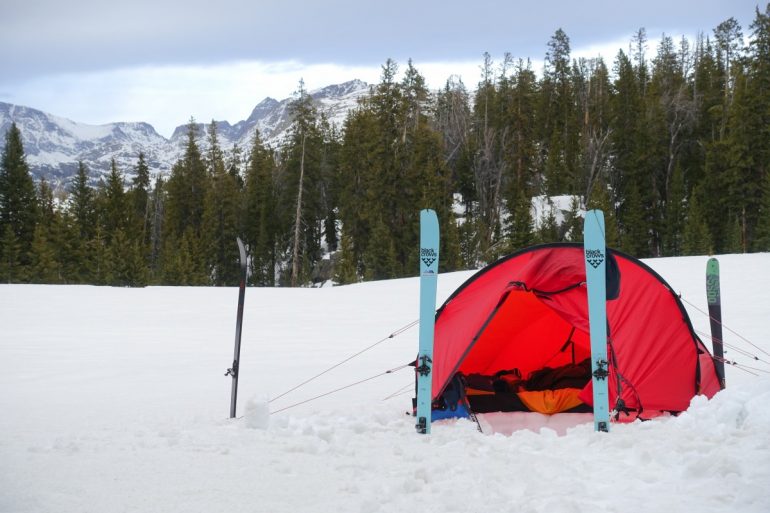
Shown here, the Hilleberg Nallo 3 tent. This three person storm-worthy tent provided a warm sleep climate. All for a slick ~ 2.2 kg/4lbs 14oz wihout stuff sacks and stakes. We split the tent into three parts and divided the weight: poles, outer tent, fly.
Brian Parker
The Warmish (Goldilocks) Sleeper
I’m the middle child of this group: I don’t sleep super warm, nor too cold, just like my porage (the three bears were totally down with carbo-loading, no?). I also don’t have the extensive “disaster style” experience to quell my fear of sleepless nights that Kelly has. I’m not falling into the 30-degree sleeping bag heresy on a trip like this. In my opinion, there’s no reason to blur the strict boundaries between Type I and Type II fun when it comes to sleep. Also of note, I’m a 9-5 working stiff, not a Patagonia gear tester nor Wildsnow editor; gear is not thrown at me.
If you’re sensing any schwag envy, it’s in your head, really.
But, yes, I have a modest quiver of sleeping bags, but the bag I brought is my lightest, most packable bag, and has kept me warm through a huge cross-section of Wyoming weather, sans the depth of winter.
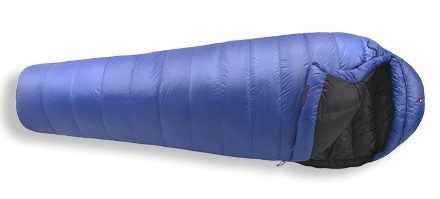
The venerable Marmot Helium 15-degree down sleeping bag.
Sleeping Bag: Older version of the Marmot Helium 15-degree down sleeping bag.
My sleep system changed little from last year’s Winds trip. I used an OG version of the venerable Marmot Helium 15-degree sleeping bag on both excursions (freaking love this bag, a bit remiss my son has started to bogart it on family adventures). The new version comes stock with a near full-length side zip; the zip system on my older Helium 15-degree also runs down the side but for ½ the bag’s length (ounces make pounds). The Helium is filled with 800+ Goose down. It weighs ~935g/2 lbs. without a stuff sack.
Technically, this is a three-season bag. The latest version (mine’s too old to find stats), according to Marmot, has a tested comfort rating of 22-degrees and a lower tested limit of 10-degrees. I’d say the 15-degree rating is accurate for those of us warmish (Goldilocks) sleepers. The fit of the bag is a traditional mummy. I’ve got room inside for extra clothes, thrash about in a semi-controlled manner, and side sleep. However, due to the lack of a full zip to vent, better place your bet it’s going to be chilly.
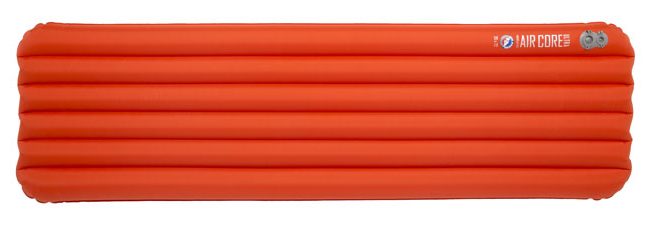
Big Agnes Air Core Ultra (22oz/624g) sleeping pad as part of my sleep system. The comparative R-value, at 1.4, is significantly lower than Kelly’s (5.4) and Jason’s (6.9) sleeping pad choices.
Sleeping Pad: Big Agnes Air Core Ultra 25″x78″
I also used a Big Agnes Air Core Ultra (624g/1.4 lbs.) sleeping pad as part of my sleep system. The comparative R-value, at 1.4, is significantly lower than Kelly’s (5.4) and Jason’s (6.9) sleeping pad choices. Their pads both measure 2.5″ in thickness; the Air Core Ultra measures a full ¾” thicker at 3.25″. I have a Big Agnes Insulated Q Core (964g/2.12 lbs.) that I use for river trips and horse packing, but I was trying to cut weight wherever possible, so I took the Air Core Ultra at the expense of insulative value based on the forecast. Big Agnes says their pads with a R-value of 3 or higher are for colder seasons. The Air Core Ultra pad is also about $140.00 retail in the 78″ length, whereas the regular size NeoAir XTherm will cost you $230.00, while the Neo XLite costs $200.00 in size regular. My pad is rectangular. The other two pads mentioned above are mummy-shaped.
Unlike Jason in the warmer bag, who stripped down to who knows what, but pretty sure I caught sight of something skimpy in a leopard skinned motif — looked very euro and probably Dynafit— I slept in the following clothes. Up top, I wore a Patagonia Airshed Pro with a short sleeve light-Capilene as an upper base layer. If it felt like it was going to be cold, or we slept higher, I donned my hooded Arc’teryx AT Proton FL jacket. I always slept in a hat and used earplugs. (Note, all three of us wore Airshed Pros daily as we skinned and skied. This was the one piece of agreed-upon cannot-do-without clothing item.)
Stay focused here because this upcoming piece is a gem. KUIU makes the piece I’m referring to, they are a hunting-focused outdoor gear/clothing company. (I live in Wyoming; of course, I hunt. And Jason and Kelly enjoyed the elk tacos.) The bottoms I cherish are the Ultra Merino 145 Zip-off bottoms. Yup, a 90% merino wool 10% nylon 3/4 length bottom layer. With the full side zips, and boot top length, you can, if you desire, wear them under ski pants without interfering with your boots.
The Ultra Merino 145s are a super versatile long underwear option, particularly for shoulder seasons, spring tours, or chasing elk in the fall. The beauty is you can wear them under softshell pants, which I both hunt and ski in. Use them during cool mornings, then as the day heats up, drop trow, unzip and voila, you’re off again; easy on and easy off. There is no need to take your ski pants off to strip this baselayer. These are also quite sweet under hard shells; they allow copious venting.
Based on the pre-trip forecast, I made the last-minute call to drop my puffy pants but kept the KUIUs for additional layering flexibility. No regrets about this call. One colder night, I did wear my softshell pants, but that was overkill and too warm.
Pre-sleep/during sleep routine:
My pre-sleep routine was basic. I hydrated pre and post after dinner with a warm drink and a Nuun tab and often ate a snack before bed. There was no pee bottle system for me. I’ll also attest that this year’s shelter selection, the Nallo 3 tent, was markedly warmer than last year’s selection of a mid.
Jason Albert comes to WildSnow from Bend, Oregon. After growing up on the East Coast, he migrated from Montana to Colorado and settled in Oregon. Simple pleasures are quiet and long days touring. His gray hair might stem from his first Grand Traverse in 2000 when rented leather boots and 210cm skis were not the speed weapons he had hoped for. Jason survived the transition from free-heel kool-aid drinker to faster and lighter (think AT), and safer, are better.
